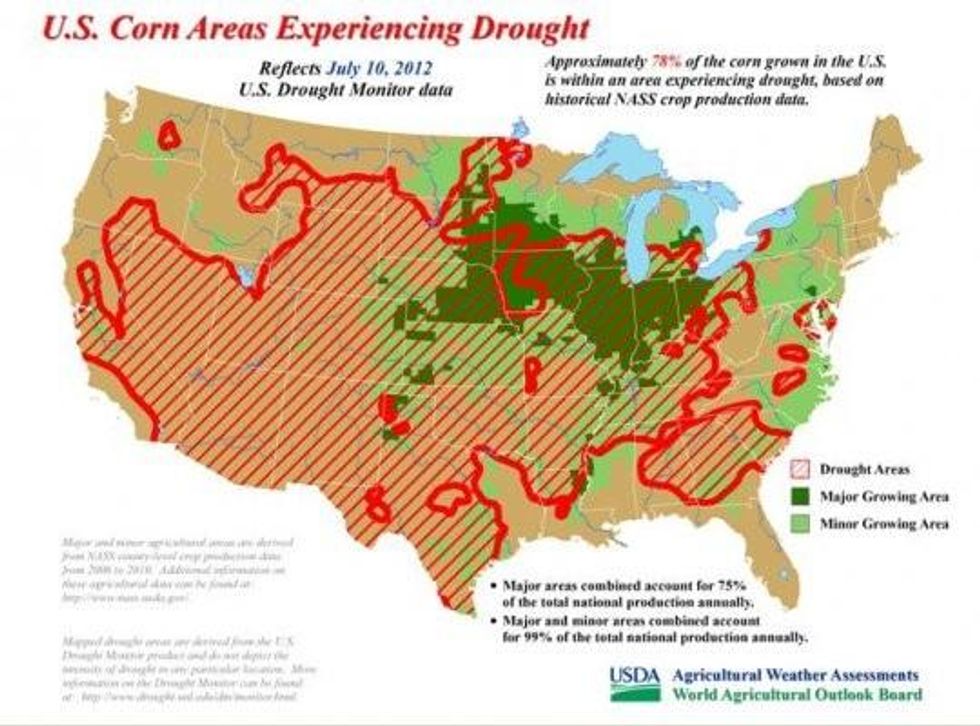Continuing Drought, Heat Bring Fear of Global Food Crisis
The continuing drought and record heat leaving parched crops in their wake have pushed corn and soy prices to historic highs as farmers and analysts suggest the consequences could be widespread and include spikes in global food prices.
Areas of Illinois and Iowa, the nation's top corn and soy producers, continue to sizzle with some areas in the 100s with little hope for much-needed rain. Jason Nicholls, meteorologist for AccuWeather, said the areas might see "Only isolated rains, no drought buster."
The continuing drought and record heat leaving parched crops in their wake have pushed corn and soy prices to historic highs as farmers and analysts suggest the consequences could be widespread and include spikes in global food prices.
Areas of Illinois and Iowa, the nation's top corn and soy producers, continue to sizzle with some areas in the 100s with little hope for much-needed rain. Jason Nicholls, meteorologist for AccuWeather, said the areas might see "Only isolated rains, no drought buster."
"It will be cooler on Friday but the heat will be back for the weekend into early next week. The 11- to 15-day forecast shows the ridge moving west over the Rockies so that may help cut back on the heat, but there is still no significant rain in sight," Nicholls said.
Chicago Board of Trade (CBOT) corn and soybean are both at record highs on Thursday,
Illinois corn farmer Steve Gartner points to parched roots of his corn crops six feet down, and says this situation is even worse than what is depicted. "It's worse I think than the markets have realized, and it's going to have huge implications, not just for us, but for prices in the grocery stores and many things we're not even thinking of," Gartner said.
Francesco Femia and Caitlin Werrell of the Center for Climate and Security say those implications are global.
"As a leading exporter of corn and soy, the U.S. is intricately linked to the global food market," they write. "Drought and crop failure in the U.S. could spike world food prices and have serious implications for places like Mexico, China, Central America and India, who rely heavily on imports of these crops, as well as animal feed."
Femia and Werrell say that this is part of "the globalization of hazards" and could have far reaching consequences. "What we've seen is that spikes in world food prices have increased the likelihood of instability and riots. In some instances, crop failure in one part of the world is associated with instability halfway around the globe, can contribute to serious diplomatic crises between the U.S. and its allies -- as occurred with Egypt -- and could conceivably result in U.S. military involvement."
An Urgent Message From Our Co-Founder
Dear Common Dreams reader, The U.S. is on a fast track to authoritarianism like nothing I've ever seen. Meanwhile, corporate news outlets are utterly capitulating to Trump, twisting their coverage to avoid drawing his ire while lining up to stuff cash in his pockets. That's why I believe that Common Dreams is doing the best and most consequential reporting that we've ever done. Our small but mighty team is a progressive reporting powerhouse, covering the news every day that the corporate media never will. Our mission has always been simple: To inform. To inspire. And to ignite change for the common good. Now here's the key piece that I want all our readers to understand: None of this would be possible without your financial support. That's not just some fundraising cliche. It's the absolute and literal truth. We don't accept corporate advertising and never will. We don't have a paywall because we don't think people should be blocked from critical news based on their ability to pay. Everything we do is funded by the donations of readers like you. Will you donate now to help power the nonprofit, independent reporting of Common Dreams? Thank you for being a vital member of our community. Together, we can keep independent journalism alive when it’s needed most. - Craig Brown, Co-founder |
The continuing drought and record heat leaving parched crops in their wake have pushed corn and soy prices to historic highs as farmers and analysts suggest the consequences could be widespread and include spikes in global food prices.
Areas of Illinois and Iowa, the nation's top corn and soy producers, continue to sizzle with some areas in the 100s with little hope for much-needed rain. Jason Nicholls, meteorologist for AccuWeather, said the areas might see "Only isolated rains, no drought buster."
"It will be cooler on Friday but the heat will be back for the weekend into early next week. The 11- to 15-day forecast shows the ridge moving west over the Rockies so that may help cut back on the heat, but there is still no significant rain in sight," Nicholls said.
Chicago Board of Trade (CBOT) corn and soybean are both at record highs on Thursday,
Illinois corn farmer Steve Gartner points to parched roots of his corn crops six feet down, and says this situation is even worse than what is depicted. "It's worse I think than the markets have realized, and it's going to have huge implications, not just for us, but for prices in the grocery stores and many things we're not even thinking of," Gartner said.
Francesco Femia and Caitlin Werrell of the Center for Climate and Security say those implications are global.
"As a leading exporter of corn and soy, the U.S. is intricately linked to the global food market," they write. "Drought and crop failure in the U.S. could spike world food prices and have serious implications for places like Mexico, China, Central America and India, who rely heavily on imports of these crops, as well as animal feed."
Femia and Werrell say that this is part of "the globalization of hazards" and could have far reaching consequences. "What we've seen is that spikes in world food prices have increased the likelihood of instability and riots. In some instances, crop failure in one part of the world is associated with instability halfway around the globe, can contribute to serious diplomatic crises between the U.S. and its allies -- as occurred with Egypt -- and could conceivably result in U.S. military involvement."
The continuing drought and record heat leaving parched crops in their wake have pushed corn and soy prices to historic highs as farmers and analysts suggest the consequences could be widespread and include spikes in global food prices.
Areas of Illinois and Iowa, the nation's top corn and soy producers, continue to sizzle with some areas in the 100s with little hope for much-needed rain. Jason Nicholls, meteorologist for AccuWeather, said the areas might see "Only isolated rains, no drought buster."
"It will be cooler on Friday but the heat will be back for the weekend into early next week. The 11- to 15-day forecast shows the ridge moving west over the Rockies so that may help cut back on the heat, but there is still no significant rain in sight," Nicholls said.
Chicago Board of Trade (CBOT) corn and soybean are both at record highs on Thursday,
Illinois corn farmer Steve Gartner points to parched roots of his corn crops six feet down, and says this situation is even worse than what is depicted. "It's worse I think than the markets have realized, and it's going to have huge implications, not just for us, but for prices in the grocery stores and many things we're not even thinking of," Gartner said.
Francesco Femia and Caitlin Werrell of the Center for Climate and Security say those implications are global.
"As a leading exporter of corn and soy, the U.S. is intricately linked to the global food market," they write. "Drought and crop failure in the U.S. could spike world food prices and have serious implications for places like Mexico, China, Central America and India, who rely heavily on imports of these crops, as well as animal feed."
Femia and Werrell say that this is part of "the globalization of hazards" and could have far reaching consequences. "What we've seen is that spikes in world food prices have increased the likelihood of instability and riots. In some instances, crop failure in one part of the world is associated with instability halfway around the globe, can contribute to serious diplomatic crises between the U.S. and its allies -- as occurred with Egypt -- and could conceivably result in U.S. military involvement."


